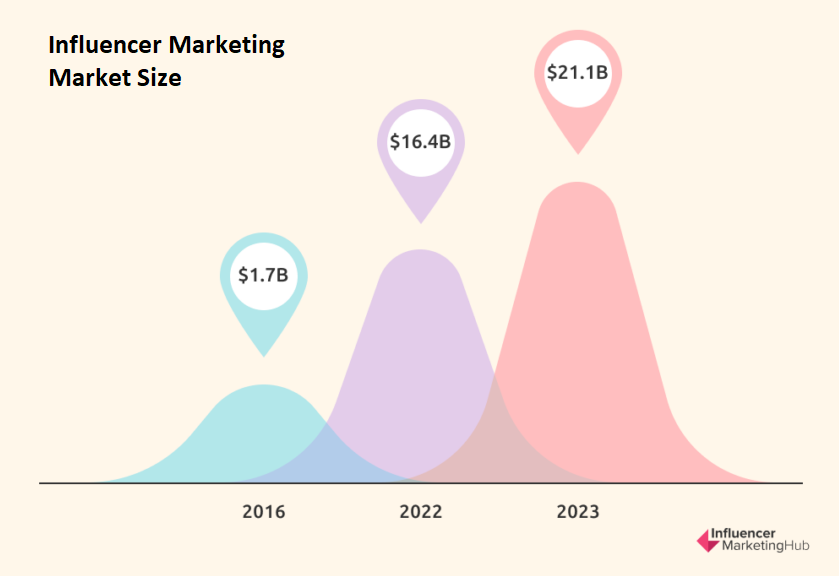How To Effectively Implement Influencer Marketing For Your Brand

In the last decade, the increased use of smartphones and the seamless accessibility of the internet have given rise to a vast online audience and a successful community of content creators. Influencers, individuals who have garnered substantial followings on various online platforms, have emerged as pivotal figures in shaping online consumer trends and preferences. This change in consumer behavior has prompted brands to recalibrate their marketing approaches, placing a greater emphasis on digital channels to connect with their intended audiences. Gradually, brands began incorporating influencer marketing into their campaigns as a central tactic for promoting their products and services.

In this blog, we will go through the step-by-step process of understanding influencer marketing, how to implement influencer marketing effectively for your brand, and what things we need to research before starting to work with an influencer to promote your brand’s products or services.
Go to our services page to explore all the services that Webandcrafts offer. With more than a decade of experience, we deliver experiences that change the way your customers feel about your business - Learn more.
Who is an influencer?
Influencers are individuals who have developed a significant following on various social media platforms or other online channels. They wield influence over their audience due to their expertise, personality, lifestyle, or content. Influencers can be found across social media platforms such as Instagram, Facebook, YouTube, TikTok, and more.
What is influencer marketing?
Influencer marketing is a strategic approach wherein brands often collaborate with influencers to promote their products or services. The idea is that the influencer's endorsement and engagement with their audience can effectively reach and impact potential consumers.
Influencer marketing often involves sponsored content, product placements, or collaborations, aiming to create a genuine association between the brand and the influencer's audience. Successful influencer marketing often requires seamless social media management to optimize content distribution and audience engagement.
Step-by-step guide How To Effectively Implement Influencer Marketing For Your Brand
1. Identify Your Goals
Influencer marketing consists of various goals, and the specific objectives can vary depending on a brand's overall marketing strategy. Here are some common goals associated with influencer marketing:
- Brand Awareness: Introduce or reinforce brand visibility by leveraging the influencer's reach to expose the brand to a larger audience.
- Audience Engagement: Foster engagement with the target audience through the influencer's authentic and relatable content, encouraging interaction and dialogue.
- Product or Service Promotion: Increase sales or usage of specific products or services by having influencers showcase and endorse them in a compelling manner.
- Content Creation: Collaborate with influencers to generate high-quality, engaging content that can be repurposed across various marketing channels.
- Social Media Growth: Boost the brand's social media following and engagement by associating with influencers who have a strong presence on those platforms.
- Influencer Credibility Transfer: Leverage the influencer's credibility and authority to build trust among their followers, associating positive sentiments with the brand.
- Event Promotion: Use influencers to create awareness and excitement around events, product launches, or brand initiatives.
- SEO and Online Presence: Improve online visibility and search engine optimization through influencer-generated content and backlinks.
- Targeted Audience Reach: Collaborate with influencers whose followers align with the brand's target demographics, ensuring more effective and relevant outreach.
- Community Building: Establish a sense of community around the brand by leveraging the influencer's ability to connect with their audience on a personal level.
- Market Research: Gain insights into consumer preferences, feedback, and trends by monitoring audience responses to influencer content.
2. Define Your Target Audience
The target audience is the specific group of individuals or demographic segment that a brand aims to reach, engage, and influence through collaborations with influencers. Identifying a well-defined target audience is crucial in influencer marketing as it helps brands tailor their messaging, content, and influencer selection to resonate effectively with the intended consumers. The target audience is characterized by various factors such as age, gender, interests, behaviors, location, and other demographic or psychographic attributes.
By understanding and defining the target audience, brands can strategically choose influencers whose followers align with these characteristics. This alignment enhances the authenticity and relevance of the influencer's promotional content, increasing the likelihood of positive engagement and influencing consumer behavior. Successful influencer marketing campaigns carefully consider and tailor their approach to the preferences and traits of their target audience to achieve optimal impact and return on investment.
3. Research and Select Influencers
Selecting the right influencer for marketing involves thorough research and consideration of various factors to ensure alignment with your brand, goals, and target audience. This step is important as this determines your conversion rates and chances of winning a loyal customer. Here are the things to research on before choosing your influencer:
- Define Your Goals: Clearly outline your marketing objectives, whether it's brand awareness, product promotion, or community engagement.
- Identify Your Target Audience: Understand the demographics, interests, and behaviors of your target audience to find influencers whose followers match your ideal consumers.
- Research Platforms: Identify the social media platforms where your target audience is most active. Different influencers thrive on different platforms.
- Look for Relevance: Seek influencers whose content aligns with your brand's values, products, or services. Authenticity is key for effective influencer marketing.
- Engagement Metrics: Analyze influencers' engagement metrics (likes, comments, shares) to gauge their impact and connection with their audience.
- Follower Demographics: Check the demographics of an influencer's followers. Ensure they match your target audience for maximum impact.
- Content Quality: Assess the quality and style of an influencer's content. Look for professionalism, creativity, and consistency.
- Authenticity and Trustworthiness: Evaluate an influencer's authenticity and trustworthiness by reviewing their past collaborations, testimonials, and overall online presence.
- Reach and Audience Size: Consider the influencer's reach and audience size. While macro-influencers have a larger following, micro-influencers may have more engaged and niche audiences.

- Check for Brand Affiliations: Ensure that the influencer hasn't recently collaborated with competitors or posted conflicting content that could impact your brand image.
- Negotiate Terms: Once you've identified potential influencers, negotiate terms such as compensation, deliverables, timelines, and any exclusivity agreements.
- Monitor Performance: Track the performance of influencer collaborations using relevant metrics and adjust strategies based on the results.
4. Build Long-Term Relationships
Successful influencer marketing is built on trust, transparency and genuine collaboration. By fostering positive relationships, brands can maximize the impact of their influencer marketing efforts and create lasting partnerships with influencers.
- Authentic Communication: Initiate communication in a genuine and personalized manner. Avoid generic messages and express why you believe the collaboration would be a good fit.
- Flexibility and Collaboration: Be flexible and open to collaboration. Allow influencers creative freedom while maintaining alignment with your brand's guidelines.
- Build Long-Term Partnerships: Consider establishing long-term partnerships with influencers rather than one-off collaborations. This fosters continuity and deeper connections with their audience.
- Recognition and Appreciation: Acknowledge and appreciate influencers for their contributions. Share their content, tag them on social media, and express gratitude for their involvement.
- Provide Resources and Support: Offer the necessary resources and support to facilitate a smooth collaboration. This could include providing product samples, access to information, or creative assets.
- Feedback and Evaluation: Provide constructive feedback after the campaign. Discuss what worked well and areas for improvement to enhance future collaborations.
- Engagement Beyond Campaigns: Engage with influencers beyond specific campaigns. Interact with their content, participate in discussions, and maintain an ongoing relationship.
- Regular Communication: Keep communication channels open. Regularly check in with influencers, share updates, and involve them in discussions about upcoming projects.
5. Negotiate Terms and Contracts
Ensuring a mutual understanding of expectations and what each party is willing to offer is crucial. Therefore, reviewing the key considerations below can assist in making an informed decision.
- Establish Clear Expectations: Clearly define campaign goals, expectations, and deliverables. Make sure both parties have a shared understanding of the collaboration's objectives.
- Mutually Beneficial Arrangements: Ensure that the collaboration offers value to both parties. Consider the influencer's audience and align campaign goals with their interests.
- Transparent and Fair Compensation: Be transparent about compensation and provide fair remuneration for the influencer's work. This will help build trust and a positive working relationship.
- Deliverables and Timeline: Specify the scope of work, including the number and type of posts, content format, content marketing, and any specific requirements. Set a realistic timeline for and publication.
- Exclusivity and Conflicts: Address exclusivity agreements to prevent influencers from promoting competing products during and for a specified period after the campaign. Clearly outline any potential conflicts of interest.
- Usage Rights: Clearly define the rights the brand has over the influencer's content. This includes how the content can be used, repurposed, and whether the influencer can use the content for personal promotion.
- Creative Freedom: Discuss the level of creative freedom the influencer will have. While providing guidelines is essential, allowing influencers some flexibility often results in more authentic and engaging content.
- Disclosure and Compliance: Ensure influencers comply with relevant advertising and disclosure regulations. Clearly state the need for proper disclosure of sponsored content.
- Measurement Metrics: Define key performance indicators (KPIs) and how success will be measured. This could include engagement rates, reach, click-through rates, or other relevant metrics.
- Revisions and Edits: Specify the process for revisions and edits. Clearly outline how feedback will be provided, and the number of revisions allowed, if any.
- Force Majeure Clause: Include a force majeure clause to address unforeseen circumstances that may affect the execution of the campaign, such as natural disasters or unforeseen events.
- Termination Clause: Clearly outline conditions under which either party can terminate the agreement, including notice periods and reasons for termination.
- Confidentiality: If applicable, include a confidentiality clause to protect sensitive information shared during the collaboration.
- Payment Terms and Invoicing: Clearly define payment terms, including the timing of payments and the preferred method of invoicing.
- Dispute Resolution: Include a clause outlining the process for resolving disputes, whether through negotiation, mediation, or legal action.
- Review by Legal Counsel: For significant partnerships, both parties may consider having the contract reviewed by legal counsel to ensure clarity and enforceability.
6. Content Collaboration
Content collaboration in influencer marketing involves influencers and brands working together to create engaging and authentic content that resonates with the target audience. Here are key considerations for successful content collaboration:
- Shared Vision and Objectives: Ensure both the brand and the influencer have a shared vision for the campaign and clearly defined objectives. This alignment is crucial for a cohesive content strategy.
- Understanding the Audience: Collaborate on understanding the target audience and tailor the content to meet their preferences, interests, and behaviors
- Creative Freedom: Allow influencers creative freedom within the agreed-upon guidelines. Influencers often connect better with their audience when they can infuse their personal style into the content.
- Brand Guidelines: Provide clear brand guidelines to maintain consistency and align the content with the brand's image. Include specifications for visuals, tone, messaging, and any branding elements.
- Content Format: Determine the most effective content format for the campaign, whether it's images, videos, stories, or a combination. Consider the platform preferences of the target audience.
- Storytelling and Narrative: Work together on crafting a compelling narrative that tells a story about the brand or product. Storytelling can significantly enhance the impact and memorability of the content.
- Integration of Brand Message: Seamlessly integrate the brand message into the content. The promotion should feel natural and not forced to maintain authenticity.
- Engagement Strategies: Discuss strategies to encourage audience engagement, such as calls-to-action, polls, or giveaways. Engaging content contributes to increased reach and impact.
- Cross-Promotion: Explore opportunities for cross-promotion. Both the brand and influencer can share the content on their respective platforms, broadening the reach and exposure.
- Content Calendar: Establish a content calendar with agreed-upon posting schedules. This ensures a coordinated effort and prevents any last-minute issues.
- Feedback and Collaboration: Foster an open line of communication for feedback and collaboration. Both parties should feel comfortable providing input to refine the content and optimize performance.
- Monitoring and Analytics: Implement tracking mechanisms to monitor the performance of the content. Use analytics to evaluate key performance indicators and adjust strategies if needed.
- Long-Term Relationships: Consider building long-term relationships with influencers for sustained content collaboration. This allows for deeper connections with the audience over time.
- Legal Considerations: Address legal aspects, such as usage rights, in the collaboration agreement to avoid any misunderstandings regarding the ownership and use of the content.
7. Legal and Ethical Compliance
Legal and ethical compliance in influencer marketing is essential to maintain transparency, trust, and adhere to regulatory guidelines. Here are key considerations:
- Disclosure of Partnerships: Ensure influencers clearly disclose their partnerships with brands. This is a legal requirement in many jurisdictions to inform the audience that the content is sponsored.
- Authenticity and Honesty: Encourage influencers to maintain authenticity and honesty in their content. They should genuinely reflect their experiences with the brand or product.
- Truth in Advertising Laws: Abide by truth in advertising laws, ensuring that all claims made about the product or service are accurate and supported by evidence.
- Copyright and Intellectual Property: Clarify ownership of content and usage rights in the influencer agreement. Respect intellectual property laws and secure permissions for any third-party content used.
- Data Privacy: Adhere to data privacy laws and regulations. Ensure that the influencer marketing campaign complies with the General Data Protection Regulation (GDPR) or any other applicable data protection laws.
- Endorsement Guidelines: Familiarize yourself with endorsement guidelines relevant to your industry. Be aware of any specific regulations governing endorsements in areas such as health, finance, or food.
- Avoid Deceptive Practices: Do not engage in deceptive practices. Clearly communicate the nature of the collaboration to prevent any misleading perceptions among the audience.
- Competitor Collaboration: Be cautious when collaborating with influencers who have recently promoted competing products. Ensure that there are no conflicts of interest that could compromise the campaign.
- Monitoring Influencer Behavior: Regularly monitor influencer behavior to ensure compliance with agreed-upon guidelines. Address any deviations promptly to maintain brand integrity.
- Influencer Contract: Draft a comprehensive influencer contract that outlines legal and ethical expectations. Include clauses related to disclosure, usage rights, compensation, and termination.
- Age Restrictions: Ensure compliance with age restrictions when promoting products or services that have age-specific regulations, such as alcohol, tobacco, or certain content aimed at children.
- Sweepstakes and Contests: If running sweepstakes or contests, comply with laws related to promotions. Clearly state terms and conditions, eligibility criteria, and prizes.
- Review by Legal Counsel: For significant influencer collaborations, consider having the influencer agreement reviewed by legal counsel to ensure compliance with relevant laws and regulations.
- Stay Informed: Stay informed about changes in laws and regulations related to influencer marketing. Regularly update influencer contracts and guidelines to reflect any legal developments.
8. Engage in User-Generated Content
Engaging in user-generated content (UGC) is a potent strategy within influencer marketing, involving the encouragement and showcasing of content created by the audience. To effectively leverage UGC in your influencer marketing efforts, it's essential to establish clear campaign objectives. Whether aiming to increase brand awareness, drive engagement, or gather user testimonials, having well-defined goals guides your strategy.
Collaborate with influencers to kickstart the UGC campaign, as they can set the tone and inspire their followers to participate in creating content. Clearly communicate guidelines for user-generated content, ensuring alignment with your brand values and campaign objectives. Include instructions for proper disclosure and legal compliance to maintain transparency.
Develop a unique and memorable branded hashtag to unify UGC submissions, facilitating tracking and showcasing content across social media platforms. Foster creativity among participants by encouraging them to express their unique perspectives, experiences, and creativity related to your brand. Provide incentives for participation, such as exclusive discounts, giveaways, or the chance to be featured on your official channels, motivating users to contribute.
Request influencers to feature selected UGC on their platforms, creating exposure for participants and fostering a sense of community around the brand. Actively engage with UGC submissions, liking, commenting, and sharing to acknowledge and appreciate participants, strengthening the sense of community and loyalty. Implement a content moderation strategy to filter and showcase the most relevant and high-quality UGC, maintaining a positive and consistent brand image.
9. Adapt and Iterate
Adaptation and iteration are fundamental aspects of a successful influencer marketing strategy, enabling brands to remain relevant, address changing trends, and optimize their approach. To effectively incorporate adaptation and iteration, it is crucial to adopt a proactive and flexible mindset.
- Monitor Trends and Audience Behavior: Stay abreast of industry trends and shifts in audience behavior. Regularly assess the landscape for changes in popular platforms, emerging content formats, and evolving influencer dynamics.
- Flexible Campaign Strategies: Design influencer marketing campaigns with flexibility in mind. Create strategies that allow for adjustments based on real-time data, audience feedback, and the dynamic nature of the social media environment.
- Data-Driven Insights: Leverage analytics tools to gather data-driven insights. Evaluate the performance of past influencer campaigns to identify successful elements and areas for improvement, informing future strategies.
- Listen to Audience Feedback: Actively engage with audience feedback on social media channels. Pay attention to comments, messages, and mentions to understand how the audience perceives and engages with influencer content.
- Adapt to Platform Changes: Platforms frequently update algorithms and features. Stay adaptable to these changes, adjusting influencer marketing strategies to align with new platform functionalities and user experiences.
- Test and Experiment: Embrace a culture of testing and experimentation. Try new content formats, collaboration approaches, or campaign structures to identify what resonates best with your target audience.
- Regularly Reevaluate Influencer Selection: Influencers' popularity and audience dynamics can change. Regularly reassess your influencer selection criteria to ensure alignment with your brand and evolving target audience.
- Iterate Content Strategies: Based on insights from analytics, iterate content strategies. Experiment with different storytelling approaches, messaging tones, and visual styles to determine the most effective communication methods.
- Optimize Collaboration Processes: Continuously optimize your collaboration processes with influencers. Streamline communication, feedback loops, and contractual agreements to enhance efficiency and effectiveness.
- Embrace New Platforms: Explore emerging social media platforms and trends. Embracing new platforms can provide opportunities to engage with different audience segments and stay ahead of the competition.
- Learn from Campaign Outcomes: Treat every influencer campaign as a learning opportunity. Analyze the outcomes, understand what worked well, and identify areas that need improvement for future iterations.
- Stay Agile and Responsive: Cultivate an agile and responsive mindset. The ability to adapt quickly to changes in the market, audience preferences, or unforeseen circumstances is crucial for sustained success.
- Collaborative Feedback Loops: Foster collaborative feedback loops with influencers. Encourage open communication to understand their insights, experiences, and recommendations for refining future collaborations.
- Invest in Influencer Relationships: Build strong relationships with influencers. The insights gained from ongoing relationships can inform the adaptation and iteration of future campaigns.
By structuring your influencer marketing approach around these principles, you create a dynamic and responsive strategy capable of evolving with the ever-changing digital landscape and consumer behavior. This iterative process not only enhances campaign effectiveness but also fosters continuous improvement over time.
10. Diversify Across Platforms
Diversifying across platforms in influencer marketing is a strategic approach aimed at reaching a broader audience and maximizing the impact of campaigns. To effectively implement this strategy, it is essential to consider several key factors. Begin by gaining insights into the demographics and preferences of your target audience. Identify the platforms where they are most active and engaged. Once you have a clear understanding of your audience's behavior, select influencers who have a strong presence on various platforms. This may include Instagram, YouTube, TikTok, Twitter, or other channels relevant to your target demographic.
Adapt your content strategy to suit the unique features and audience behaviors of each platform. What performs well on Instagram may need to be presented differently on YouTube or TikTok. Leverage visual and multimedia content that aligns with the specific strengths of each platform, ensuring your message is communicated effectively.
Consider optimizing for search engines, particularly on platforms like YouTube. Use relevant keywords and descriptions to enhance discoverability. Explore the use of platform-specific features such as Instagram Stories, Snapchat, and TikTok Reels to create temporary and engaging content that aligns with each platform's native functionalities.
Encourage influencers to cross-promote content across different platforms, facilitating the expansion of your brand's reach and maintaining a cohesive online presence. Stay updated on changes and updates on each platform, adapting your strategy accordingly. Additionally, keep an eye on emerging social media platforms that may resonate with your target audience, providing an opportunity for early adoption.
Experiment with diverse content formats, aligning influencers with the strengths of the respective platforms. Measure and analyze the performance of influencer campaigns on each platform, assessing engagement, reach, and conversions to refine your strategy over time. Adapt your content and strategy based on the trends and preferences of each platform's user base, ensuring that your brand message remains relevant and resonates with the audience.
Despite diversifying across platforms, maintain a cohesive brand message and identity. Consistency is key to building a strong and recognizable brand presence. Distribute your influencer marketing budget across various platforms based on their relevance and potential impact on your target audience. By considering these factors, you can create a comprehensive and effective influencer marketing strategy that leverages the strengths of different platforms.
Conclusion
Influencer marketing, when executed strategically, can be a powerful tool to enhance brand visibility, reach new audiences, and build credibility. It's essential to approach influencer partnerships authentically and to continuously evaluate and refine your strategy based on performance metrics and feedback.
FAQs
- Guide to Winning with PPC: Optimizing Your Paid Search Strategy
- WAC Beyond 2025: Kerala’s First Flagship Tech and Marketing Summit Marks 13 Years of Innovation
- Customer vs Consumer: What's the Difference?
- How to Increase Views on Instagram Reels in 2026 – Proven Viral Hacks
- Email Writing Format: How to Write an Email Effectively (Tips and Examples)
Discover Digital Transformation
Please feel free to share your thoughts and we can discuss it over a cup of tea.









